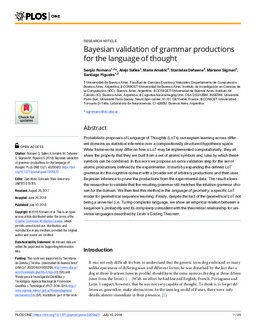Mostrar el registro sencillo del ítem
Bayesian validation of grammar productions for the language of thought
| dc.rights.license | https://creativecommons.org/licenses/by/4.0/ | es_AR |
| dc.contributor.author | Romano, Sergio | es_AR |
| dc.contributor.author | Salles, Alejo | es_AR |
| dc.contributor.author | Amalric, Marie | es_AR |
| dc.contributor.author | Deahene, Stanislas | es_AR |
| dc.contributor.author | Sigman, Mariano | es_AR |
| dc.contributor.author | Figueira, Santiago | es_AR |
| dc.date.accessioned | 2018-11-30T01:51:23Z | |
| dc.date.available | 2018-11-30T01:51:23Z | |
| dc.date.issued | 2018-07-10 | |
| dc.identifier.uri | https://doi.org/10.1371/journal.pone.0200420 | es_AR |
| dc.identifier.uri | ||
| dc.identifier.uri | es_AR | |
| dc.identifier.uri | es_AR | |
| dc.identifier.uri | https://repositorio.utdt.edu/handle/20.500.13098/11219 | |
| dc.description.abstract | Probabilistic proposals of Language of Thoughts (LoTs) can explain learning across differ- ent domains as statistical inference over a compositionally structured hypothesis space. While frameworks may differ on how a LoT may be implemented computationally, they all share the property that they are built from a set of atomic symbols and rules by which these symbols can be combined. In this work we propose an extra validation step for the set of atomic productions defined by the experimenter. It starts by expanding the defined LoT grammar for the cognitive domain with a broader set of arbitrary productions and then uses Bayesian inference to prune the productions from the experimental data. The result allows the researcher to validate that the resulting grammar still matches the intuitive grammar cho- sen for the domain. We then test this method in the language of geometry, a specific LoT model for geometrical sequence learning. Finally, despite the fact of the geometrical LoT not being a universal (i.e. Turing-complete) language, we show an empirical relation between a sequence’s probability and its complexity consistent with the theoretical relationship for uni- versal languages described by Levin’s Coding Theorem. | es_AR |
| dc.format.extent | 20 p. | es_AR |
| dc.format.medium | application/pdf | es_AR |
| dc.language | eng | es_AR |
| dc.relation.ispartof | PLoS ONE 13(7)), (2018). ISSN: 1932-6203 | es_AR |
| dc.rights | info:eu-repo/semantics/openAccess | es_AR |
| dc.subject | Gramática | es_AR |
| dc.subject | Lenguaje | es_AR |
| dc.subject | Teoría de la información | es_AR |
| dc.subject | Simetría | es_AR |
| dc.subject | Aprendizaje | es_AR |
| dc.subject | Lenguajes de programación | es_AR |
| dc.subject | Sintaxis | es_AR |
| dc.title | Bayesian validation of grammar productions for the language of thought | es_AR |
| dc.type | info:eu-repo/semantics/workingPaper | es_AR |
| dc.subject.keyword | Grammar | es_AR |
| dc.subject.keyword | Language | es_AR |
| dc.subject.keyword | Information theory | es_AR |
| dc.subject.keyword | Symmetry | es_AR |
| dc.subject.keyword | Learning | es_AR |
| dc.subject.keyword | Programming languages | es_AR |
| dc.subject.keyword | Syntax | es_AR |
| dc.type.version | info:eu-repo/semantics/publishedVersion | es_AR |
| dc.description.filiation | Fil: Romano, Sergio. Universidad de Buenos Aires. Facultad de Ciencias Exactas y Naturales. Departamento de Computación. Buenos Aires, Argentina. CONICET-Universidad de Buenos Aires. Instituto de Investigación en Ciencias de la Computación (ICC). Buenos Aires, Argentina | es_AR |
| dc.description.filiation | Fil: Salles, Alejo. CONICET-Universidad de Buenos Aires. Instituto de Cálculo (IC). Buenos Aires, Argentina | es_AR |
| dc.description.filiation | Fil: Amalric, Marie. Cognitive Neuroimaging Unit, CEA DSV/I2BM, INSERM, Université Paris-Sud, Université Paris-Saclay, NeuroSpin center, 91191 Gif/Yvette, France | es_AR |
| dc.description.filiation | Fil: Deahene, Stanislas. Cognitive Neuroimaging Unit, CEA DSV/I2BM, INSERM, Université Paris-Sud, Université Paris-Saclay, NeuroSpin center, 91191 Gif/Yvette, France | es_AR |
| dc.description.filiation | Fil: Sigman, Mariano CONICET-Universidad Torcuato Di Tella. Escuela de Negocios. Laboratorio de Neurociencia, Buenos Aires, Argentina | es_AR |
| dc.description.filiation | Fil: Figueira, Santiago. Universidad de Buenos Aires. Facultad de Ciencias Exactas y Naturales. Departamento de Computación. Buenos Aires, Argentina. CONICET-Universidad de Buenos Aires. Instituto de Investigación en Ciencias de la Computacón (ICC). Buenos Aires, Argentina | es_AR |

